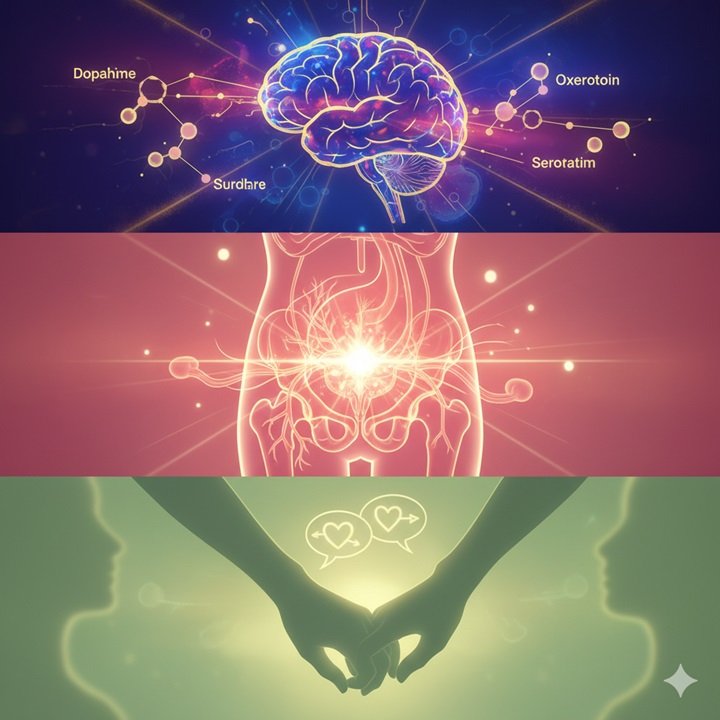
The Science of Pleasure: A Deep Dive into Arousal, Orgasm, and Intimacy
- November 2, 2025
- 0 Likes
- 36 Views
- 0 Comments
Sexual pleasure is often discussed in hushed tones or framed in cultural myths, but at its core, it is a normal, healthy, and vital part of human experience. Understanding the science behind arousal and orgasm—and how deeply intertwined they are with communication and psychological well-being—is essential for promoting sexual health and informed decision-making.
1. The Biology of Arousal: The Brain’s Role
Arousal isn’t just a physical event; it starts in the brain and is a complex interplay of hormones, neurotransmitters, and the nervous system.
Neurotransmitters: The Pleasure Cocktail
When you feel attraction or begin intimate activity, your brain floods your system with chemicals that kickstart arousal:
- Dopamine: Often called the “reward” chemical, Dopamine drives motivation and desire. It’s what makes you seek out pleasurable experiences. During arousal, it builds anticipation and excitement.
- Oxytocin: Known as the “cuddle hormone” or “bonding hormone,” Oxytocin is released during touch, kissing, and orgasm. It is crucial for feelings of trust, emotional closeness, and attachment to a partner, deepening the feeling of intimacy.
- Serotonin: This regulates mood and overall sense of well-being. While its exact role in sexual response is complex, balanced Serotonin levels are key to a healthy libido.
The Nervous System Flip
The initial physical signs of arousal (increased heart rate, breathing, blood flow) are governed by the Parasympathetic Nervous System—the “rest and digest” system. It dilates blood vessels, sending blood to the genital areas (causing lubrication in the vulva and erection in the penis) and creating the readiness for sexual activity.
2. Orgasm Mechanics: Dispelling the Myths
The orgasm is the climax of the sexual response cycle—a peak discharge of built-up neuromuscular tension resulting in involuntary muscular contractions, primarily felt in the pelvic area.
The Myth of “Clitoral vs. Vaginal”
For people with vulvas, the most enduring myth is the distinction between a “clitoral” and “vaginal” orgasm. Neurological research confirms a crucial fact: all female orgasms are ultimately rooted in the clitoris.
- The clitoris is far larger than the external “button” visible on the vulva. Its internal structure extends deeply, surrounding the urethra and vagina.
- While direct clitoral stimulation (external) is the most common path to orgasm, internal stimulation (like intercourse) can stimulate the internal branches of the clitoris, leading to the sensation often called a “vaginal orgasm.” They are simply different routes to stimulating the same pleasure center.
Multiple Orgasm Capacity
The capacity for multiple orgasms differs significantly based on anatomy:
- Bodies with Penises: Following ejaculation (and orgasm), the refractory period begins. This is a physiological recovery time during which a person cannot be re-aroused and reach orgasm again. This period can range from minutes to hours, depending on age and individual factors.
- Bodies with Vulvas: There is no physiological refractory period. Once the initial peak has passed, some individuals can be immediately restimulated to achieve a subsequent orgasm. This capacity is highly individual and often depends on the level of physical and emotional fatigue.
3. The Role of Communication in Intimacy
The most powerful “sex organ” is the brain, and the greatest enhancer of pleasure is open, honest communication.
Enthusiastic Consent as a Pleasure Multiplier
As outlined in Pillar 1, consent must be enthusiastic, continuous, and reversible. When both partners feel psychologically safe and respected, it lowers inhibitory stress hormones (like cortisol) and allows the positive, bonding neurotransmitters (like Oxytocin) to flow more freely. Knowing a partner is fully, happily present and desires the activity enhances pleasure for everyone involved.
Talking Pleasure: Sample Scripts
Discussing desire, boundaries, and preferences proactively is key to satisfying intimacy:
- About Preferences: “I really love it when you [action]. Could we try focusing on that for a bit?”
- About Boundaries: “I’m really enjoying this, but I’m not comfortable with [specific action]. Let’s try [alternative action] instead.”
- Checking In (Continuous Consent): “How does this feel right now? Are you enjoying this?”
Open communication transforms sex from a guessing game into a mutually fulfilling experience, ensuring that pleasure is centered on reciprocal enjoyment and respect.
4. Seeking Professional Guidance
This article provides general scientific insights into sexual pleasure, but individual experiences and challenges can vary widely. If you are seeking personalized advice, diagnosis, or treatment for sexual health concerns, it is recommended to consult with qualified healthcare professionals. For those in the Delhi area, professionals like Dr. P. K. Gupta, a well-known sexologist in Delhi, offer expert guidance and specialized support for intimacy and sexual wellness. Always ensure the professional you choose is appropriately licensed and accredited.


Leave Your Comment